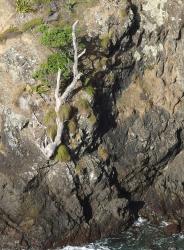- Taxon
- Gallery
- ≡ Danthonia bromoides Hook.f., Bot. Antarct. Voy. II. (Fl. Nov.-Zel.) Part I, 303 (1853)
Stout, pendent often sprawling, bright green tussock with persistent leaves and sheaths. Leaf-sheath to 15 cm, shining yellow, keeled, persistent and entire, becoming fibrous, margin abundantly long hairy below, apical tuft of hairs to 4 mm; adaxially with many minute interrib hairs. Ligule to 1.5 mm. Leaf-blade to 50 cm × 10 mm, flat or shallowly U-shaped, smooth, persistent, adaxially glabrous except for long hairs on margin below and some short or long hairs, sometimes dense, at base. Culm to 70 cm, internodes glabrous. Inflorescence to 20 cm, very congested; rachis and main branches glabrous but with some long hairs at axils; pedicels short and densely hairy. Spikelets of up to 6 florets. Glumes acute or slightly awned, < adjacent lemma lobes, many prickle-teeth abaxially and a few adaxially; lower to 12 mm, 1–3-nerved, upper to 16 mm, 5-nerved. Lemma to 9 mm; hairs dense at margin and in all internerves though sometimes absent from all or some, ≤ sinus, prickle-teeth abundant abaxially and adaxially on lobes and margins; lateral lobes to 5 mm including awn to 3 mm or acute, rarely dividing from awn at sinus; central awn to 22 mm from indistinct straight column. Palea to 10 mm, prickle-teeth abaxially and on flanks. Callus to 1.5 mm, hairs to 5 mm. Rachilla to 0.5 mm. Lodicules to 1.75 mm. Anthers to 5.5 mm in male-fertile flowers, up to 3 mm in male-sterile flowers. Gynoecium of male-fertile flowers with stigma-styles to 3.5 mm, ovary to 1.5 mm, and of male-sterile flowers to 5 mm, ovary 1.5 mm. Caryopsis to 3.5 mm. Gynodioecious. 2n= 42. Plate 8G.
[From: Edgar and Connor (2000) Flora of New Zealand. Volume 5 (second printing).]




